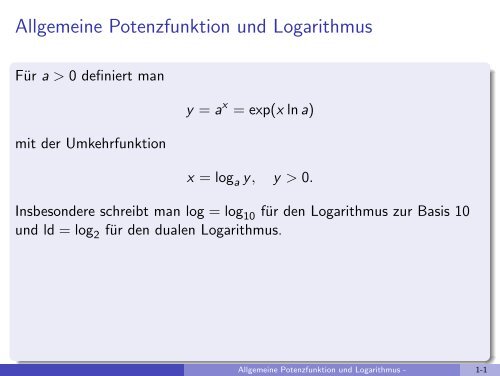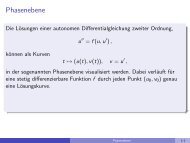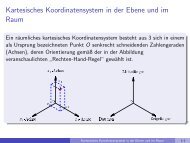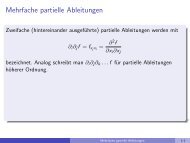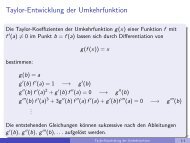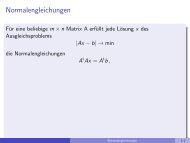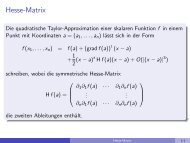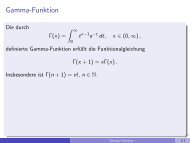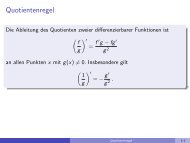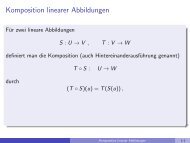Allgemeine Potenzfunktion und Logarithmus - imng
Allgemeine Potenzfunktion und Logarithmus - imng
Allgemeine Potenzfunktion und Logarithmus - imng
Sie wollen auch ein ePaper? Erhöhen Sie die Reichweite Ihrer Titel.
YUMPU macht aus Druck-PDFs automatisch weboptimierte ePaper, die Google liebt.
<strong>Allgemeine</strong> <strong>Potenzfunktion</strong> <strong>und</strong> <strong>Logarithmus</strong><br />
Für a > 0 definiert man<br />
mit der Umkehrfunktion<br />
y = a x = exp(x ln a)<br />
x = log a y, y > 0.<br />
Insbesondere schreibt man log = log 10 für den <strong>Logarithmus</strong> zur Basis 10<br />
<strong>und</strong> ld = log 2 für den dualen <strong>Logarithmus</strong>.<br />
<strong>Allgemeine</strong> <strong>Potenzfunktion</strong> <strong>und</strong> <strong>Logarithmus</strong> - 1-1
<strong>Allgemeine</strong> <strong>Potenzfunktion</strong> <strong>und</strong> <strong>Logarithmus</strong><br />
Für a > 0 definiert man<br />
mit der Umkehrfunktion<br />
y = a x = exp(x ln a)<br />
x = log a y, y > 0.<br />
Insbesondere schreibt man log = log 10 für den <strong>Logarithmus</strong> zur Basis 10<br />
<strong>und</strong> ld = log 2 für den dualen <strong>Logarithmus</strong>.<br />
16<br />
14<br />
12<br />
10<br />
8<br />
6<br />
4<br />
2<br />
−2<br />
0<br />
−1 0 1 2 3 4<br />
f (x) = 2 x<br />
4<br />
3<br />
2<br />
1<br />
0<br />
−1<br />
−2<br />
0 2 4 6 8 10 12 14 16<br />
f (x) = ld(x)<br />
<strong>Allgemeine</strong> <strong>Potenzfunktion</strong> <strong>und</strong> <strong>Logarithmus</strong> - 1-2
Beispiel:<br />
Wachstumsgesetz<br />
y = a x , a > 0<br />
<strong>Allgemeine</strong> <strong>Potenzfunktion</strong> <strong>und</strong> <strong>Logarithmus</strong> - 2-1
Beispiel:<br />
Wachstumsgesetz<br />
y = a x , a > 0<br />
(i) halblogarithmische Darstellung: log y versus x<br />
Gerade mit Steigung<br />
m = log a<br />
<strong>Allgemeine</strong> <strong>Potenzfunktion</strong> <strong>und</strong> <strong>Logarithmus</strong> - 2-2
Beispiel:<br />
Wachstumsgesetz<br />
y = a x , a > 0<br />
(i) halblogarithmische Darstellung: log y versus x<br />
Gerade mit Steigung<br />
m = log a<br />
(ii) doppelt logarithmische Darstellung: log y versus log a<br />
<strong>Allgemeine</strong> <strong>Potenzfunktion</strong> <strong>und</strong> <strong>Logarithmus</strong> - 2-3
Beispiel:<br />
Wachstumsgesetz<br />
y = a x , a > 0<br />
(i) halblogarithmische Darstellung: log y versus x<br />
Gerade mit Steigung<br />
m = log a<br />
(ii) doppelt logarithmische Darstellung: log y versus log a<br />
Anwendung bei Zeichnen von Fehlerraten<br />
ε ≈ cn −k ⇔ log ε = log c − k log n<br />
negative Steigung k entspricht Konvergenzrate<br />
<strong>Allgemeine</strong> <strong>Potenzfunktion</strong> <strong>und</strong> <strong>Logarithmus</strong> - 2-4
10 8 10 2<br />
10 x 10 0<br />
10 4<br />
10n −1<br />
10 −2<br />
10 0<br />
2 x<br />
10 −4<br />
n −2<br />
0.1 x<br />
10 −6<br />
10 −8<br />
100n −4<br />
10 −10<br />
0 2 4 6 8 10<br />
10 0 10 1 10 2 10 3<br />
10 −4<br />
10 −8<br />
<strong>Allgemeine</strong> <strong>Potenzfunktion</strong> <strong>und</strong> <strong>Logarithmus</strong> - 2-5


